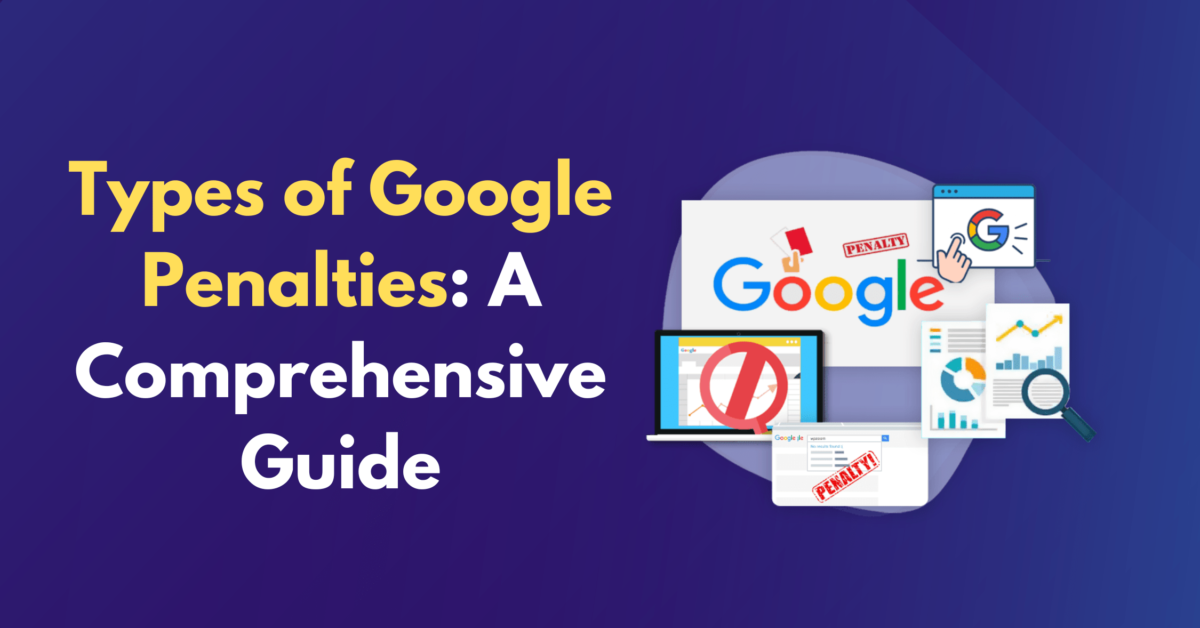A Comprehensive Guide to Types of Google Penalties
Introduction:
In the ever-evolving realm of digital marketing and search engine optimization, understanding the intricacies of Google penalties is paramount. As businesses and website owners strive to maintain or improve their online presence, the specter of a Google penalty can be daunting. But fear not, for in this comprehensive guide, we’ll demystify Google penalties, shed light on their types, and recovery strategies, and offer valuable insights to navigate this complex terrain. Let’s embark on this enlightening journey to comprehend the world of Google penalties.
Google Penalties – An Overview
Before diving into the different types of Google Penalties, let’s start with the basics. What is a Google Penalty, and why does it matter?
Google Penalties are punitive actions taken by the search engine giant against websites that violate its quality guidelines. When your website is penalized, it can suffer a significant drop in rankings, organic traffic, and, ultimately, revenue. Understanding Google Penalties is not only about avoiding them but also about being able to recover if you ever find your website on the wrong side of Google’s algorithms.
Types of Google Penalties
1) Algorithmic Penalties
Algorithmic penalties are penalties imposed by Google’s algorithms when they detect violations of their guidelines. These penalties are automatic and do not involve manual review. The two primary algorithmic penalties that websites can face are:
a. Panda Penalty
Google’s Panda algorithm is designed to assess the quality of a website’s content. Websites with thin, low-quality content or those engaged in content duplication may be penalized by Panda. To avoid a Panda penalty, focus on creating high-quality, original, and engaging content.
Example: A website that copies articles from other sources without adding value or originality may face a Panda penalty, resulting in a significant drop in rankings.
b. Penguin Penalty
The Penguin algorithm targets websites with spammy or manipulative backlinks. If your website has a history of acquiring low-quality or unnatural backlinks, you might trigger a Penguin penalty. To recover from a Penguin penalty, disavow harmful backlinks and build high-quality, relevant ones.
Example: A website that engages in link schemes, such as buying or exchanging backlinks with irrelevant websites, could be penalized by Penguin.
2) Manual Penalties
Manual penalties are imposed by human reviewers from Google’s webspam team after a thorough manual review of a website. These penalties are often more severe and specific to the issues identified. The webspam team may issue a manual penalty for various reasons, including:
a. Thin Content
Websites with low-quality, shallow, or insufficient content may receive a manual penalty. To avoid this, ensure your website provides valuable and comprehensive information.
Example: A website offering vague or incomplete product descriptions may receive a manual penalty for thin content.
b. Unnatural Link Building
If your website is involved in manipulative link-building practices, such as link schemes or buying links, you risk a manual penalty. It’s crucial to maintain a natural and ethical backlink profile.
Example: A website that buys links from questionable sources may be penalized with a manual action.
c. Keyword Stuffing
Keyword stuffing, the excessive use of keywords in an attempt to manipulate search rankings, can lead to a manual penalty. Focus on creating content that is natural and user-friendly, rather than overloading it with keywords.
Example: An e-commerce website that repeatedly uses the same keyword in product descriptions to manipulate search results may face a manual penalty.
d. Cloaking
The activity of displaying alternate information to search engines and people is known as cloaking. This deceptive tactic can result in a manual penalty. Ensure your website displays consistent content to both search engines and visitors.
Example: A website that displays content optimized for search engines but serves unrelated content to users can receive a manual penalty for cloaking.
Google Penalty Recovery
Recovering from a Google penalty is a crucial endeavor for website owners. The process may vary depending on whether the penalty is algorithmic or manual.
Algorithmic Penalty Recovery
a. Panda Penalty Recovery
Identify low-quality content: Use tools like Google Analytics to find pages with low user engagement and thin content.
Improve content:
Rewrite or expand on low-quality content, making it more valuable and engaging for users.
Request a reassessment:
After addressing the issues, submit a reconsideration request through Google Search Console.
b. Penguin Penalty Recovery
Identify toxic backlinks:
Utilize tools like Google Search Console and third-party backlink analysis tools to identify harmful backlinks.
Disavow harmful links:
Create a disavow file and submit it through Google Search Console to disassociate your website from toxic backlinks.
Build high-quality backlinks:
Focus on acquiring natural, relevant, and high-quality backlinks.
Manual Penalty Recovery
Recovering from a manual penalty requires a different approach:
a. Identify the Issue:
First, understand the specific reason for the manual penalty by reviewing the message in the Google Search Console.
b. Address the Issue:
Take immediate action to rectify the problem. Whether it’s improving content quality, removing harmful backlinks, or resolving other issues, ensure everything is in compliance with Google’s guidelines.
c. Document Changes:
Keep a detailed record of all the changes you’ve made to your website.
d. Submit a Reconsideration Request:
Prepare a well-structured reconsideration request explaining the actions you’ve taken to rectify the issue and prevent future violations.
e. Be Patient:
Google’s webspam team will review your request, and the recovery process may take some time. Wait for their reaction with patience.
What Would Result in a Google Penalty?
Understanding the potential triggers for Google penalties is essential for website owners and SEO practitioners. Here are some common practices that can lead to penalties:
Keyword Stuffing:
Overusing keywords in an attempt to manipulate search rankings is a violation of Google’s guidelines.
Cloaking:
Serving different content to search engines and users is deceptive and can result in a penalty.
Low-Quality Content:
Thin, irrelevant, or duplicate content can lead to penalties, as Google aims to provide users with valuable information.
Also Read: Creating High-Quality Content: On-Page SEO Best Practices
Spammy Backlinks:
Building or acquiring low-quality, unnatural backlinks can trigger both algorithmic and manual penalties.
Link Schemes:
Engaging in manipulative link-building practices like buying or exchanging links is a violation of Google’s policies.
Hidden Text and Links:
Hiding text or links from users but making them visible to search engines is considered deceptive and can lead to penalties.
Unnatural User Behavior:
Abnormal user behavior on your website, such as click fraud or fake engagement, can result in penalties.
Insights to Safeguard Your Online Presence
Navigating the world of Google penalties can be challenging, but with the right strategies and insights, you can safeguard your online presence effectively. Here are some valuable insights:
Stay Informed:
Regularly monitor Google’s guidelines and algorithm updates to remain in compliance.
Quality over Quantity:
Priorities are quality above quantity when it comes to content and backlinks. High-quality content and backlinks are more valuable in the long run.
Regular Audits:
Conduct periodic audits of your website to identify and rectify potential issues proactively.
Seek Professional Help:
If you’re unsure about the health of your website, consider consulting SEO experts or agencies like Metaloop Marketing for guidance.
User Experience:
Focus on providing an excellent user experience, as this is one of the key factors Google considers in its ranking algorithms.
Conclusion:-
In the dynamic world of digital marketing and SEO, understanding Google’s penalties is vital for maintaining a strong online presence. By demystifying the types of Google penalties, recovery strategies, and valuable insights, you are better equipped to navigate the complex terrain of SEO and protect your website from potential pitfalls.
Remember that Google penalties are not insurmountable obstacles. With the right knowledge, tools, and dedication, you can recover from penalties and establish a robust online presence that complies with Google’s guidelines. So, stay informed, take proactive measures, and prioritize quality in your online endeavors to ensure your website’s success in the ever-evolving digital landscape.



Write a Comment